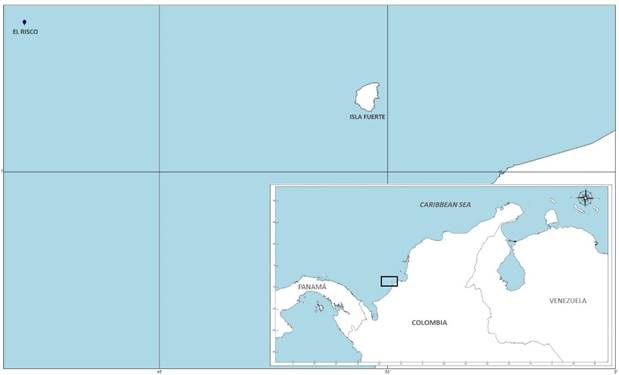Introduction
The Cuban dogfish Squalus cubensis (Howell Rivero, 1936) inhabits the subtropical Atlantic Ocean from North Carolina to southern Brazil and Argentina, including the greater Caribbean and the Gulf of Mexico (Compagno, 1984, 2002; Monzini, 2006; Jones et al, 2013; Brooks et al, 2015). Schools are probably present below 100 m in the Portobelo area (Panama, Caribbean Coast, Colon Province) and in the San Andres archipelago area (Monzini, 2006).
The Cuban dogfish is a bottom-dwelling species that inhabits deep warm temperate and tropical waters of the outer continental shelf and uppermost slopes, and is found on or near the bottom in large dense schools. Reported capture depths vary between 60 and 730.6 m (Compagno, 1984; Castro, 2011; Jones et al, 2013, Brooks et al, 2015). This species may form large schools of same-sex and size individuals (Castro, 2011) and is never found in surface waters. Juvenile Cuban dogfishes reside in shallow waters along the continental shelf and mature specimens are found in deep waters (Compagno 1984, 2002).
Little information is known about this species and separate catch statistics are not reported for any population. Information available refers to S. cubensis as by-catch of artisanal and commercial fisheries in the Caribbean, mainly caught in the northern Gulf of Mexico, although details are lacking and this species cannot be assessed beyond Data Deficient (IUCN Red List) at present (Monzini, 2006).
Previous records have reported the presence of the Cuban dogfish in Colombia only through industrial fishery studies and experimental trawl surveys (Rey-Carrasco & Acero (1988) in the continental slope of the northeastern coast; Puentes etal. (2009) in the San Andrés archipelago; and Paramo et al. (2012, 2015) across the Colombian Caribbean.
The present article describes two females captured in the southern continental shelf of the Colombian Caribbean (Figure 1), becoming the first record of this species in the area. Furthermore, some characteristics of its reproduction are described in order to provide additional information to the basic knowledge of the species.
The recording of morphometric measures was made point-to-point on the fresh specimens, using a measuring tape and a caliper, following Compagno (1984, 2001, and 2002). For pregnant females, number of embryos in utero and their sex, location (left or right uterus), and total length of each embryo (Lte) were recorded (Braccini et al, 2006).
The specimens were preserved in 5% formaldehyde, transferred to 70% alcohol and deposited under the catalog number MPUJ 7875 in the Museum of Natural History of the Pontificia Universidad Javeriana, in Bogotá-Colombia.
Results and discussion
Squaliformes Compagno, 1973
Squalidae Blainville, 1816
Squalus Linnaeus, 1758
Squalus cubensis Howell Rivero, 1936. Proc.Boston Soc.Nat.Hist., 41(4): 45, pls.10 and 11 (Figure 2).
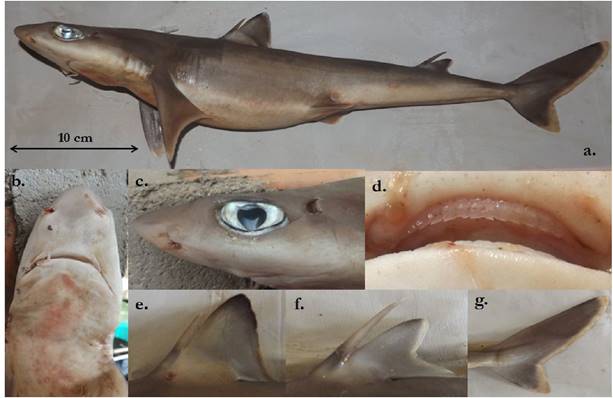
Fig. 2 Female of Squalus cubensis 51.7 cm LT. a. Side view. b. Ventral view of the head. c. Detail of the eye and spiracle. d. Detail of the upper teeth. e. First dorsal fin. f. Second dorsal fin. g. Caudal fin.
On 25 September 2014, two adult females (MPUJ 7875) were captured by artisanal fishermen through longline fishing in the limit of the southern continental shelf of the Colombian Caribbean, 27 km off Isla Fuerte and 40 km off the continental coastline at 100 meters depth, at the fishing locality named ElRisco (9° 26’ 25. 72’’ N, 76° 25’ 55. 82’’ W). The record of these two females constitutes the first report of this species in the southern continental shelf, extending its distribution range to the southern Caribbean Sea. Table 1 shows the morphological measurements taken on both specimens.
The total length (51.7 and 50 cm Lt) is larger than previous records in Colombian waters: 29.5 cm Lt northeastern coast of Colombia (Rey-Carrasco & Acero 1988). Currently, there is no additional information about the size of S. cubensis in Colombia. For other locations in the Caribbean (Jamaica, Bahamas, Gulf of Mexico and Venezuela) the size ranges vary between 21.2 and 80 cm Lt (McLaughlin & Morrissey, 2004; Jones et al, 2013; Tagliafico et al, 2014; Brooks et al, 2015).
In Colombia, the Cuban dogfish has been reported in depth ranges of 270-630 m (Rey-Carrasco & Acero, 1988) and 246-388 m (Paramo et al 2012, 2015). Other records in the Caribbean show depth ranges between 198.11 and 913 m (McLaughlin & Morrissey, 2004; Jones et al, 2013; Brooks et al, 2015). Our report constitutes the shallowest depth record for this species in the area: 100 m depth. According to Brooks et al (2015), the variation in depth is attributable to geographical variation in thermal profiles of the water column; they suggest that S. cubensis select vertical habitats based on thermal rather than barometric or photic preferences leading to the disparate depth ranges in different latitudes.
Table 1 Morphometric characters of the two females (MPUJ 7875) and other references of Squalus cubensis in the area.
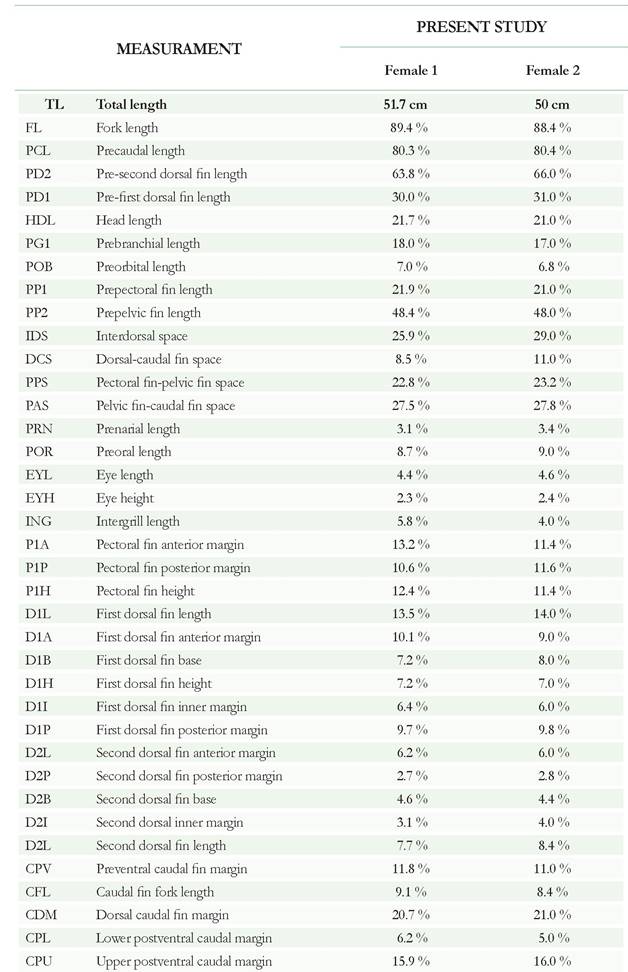
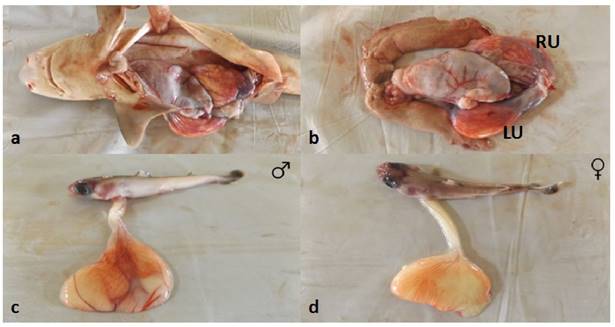
Fig. 3 Female 1. a. View of internal organs. b. RU-Right uterus and LU-Left uterus with candle inside. c. Male mid-term embryo with large external yolk sac. d. Female mid-term embryo with large external yolk sac.
Female 1 (Figure 3): Mature specimen with embryos macroscopically visible in utero. Right uterus with candle contained one mid-term embryo (male 10.2 cm Lte), with a large external yolk sac, small follicles, and enlarged oviducal gland. Left uterus with candle contained one mid-term embryo (female 10.6 cm Lt) and a large external yolk sac, small follicles, and enlarged oviducal gland (Table 2).
Female 2 (Figure 4): Mature specimen with embryos macroscopically visible in utero. Right uterus with candle contained one embryo at an early stage of development (2.2 cm Lte) and a large external yolk sac, small follicles, and enlarged oviducal gland. Left uterus empty and expanded, developing follicles, and enlarged oviducal gland (Table 2).
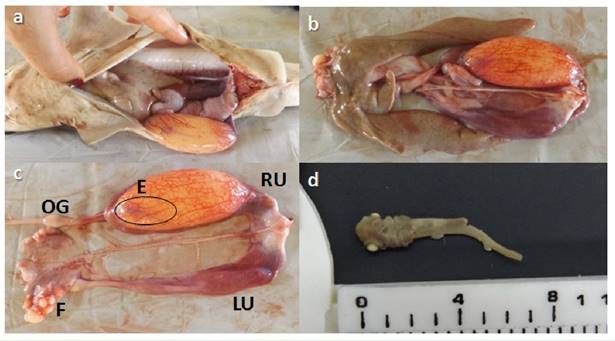
Fig. 4 Female 2. a - b View of internal organs. c. RU-Right uterus with candle inside, LU-Left uterus empty and enlarged, OG-Oviducal gland, F-Follicles, E-Embryo with a very large external yolk sac. d. Early stage embryo.
The females of the Cuban dogfish, as other dogfish sharks, are asynchronous breeders in which ovulation, parturition, and mating do not occur at any particular time of the year (Braccini et al, 2006). According to Castro (2011), females mature at 49 - 50 cm and the pups are born at 25 - 27 cm. Jones et al. (2013), estimated that during the maturation process of females, the oviducal glands width begins at approximately 42 cm Lt, followed by development of the uterus at approximately 46 cm Lt, estimating the size-at-maternity at 47.8 cm Lt, and suggested that the size-at- birth is approximately 20 cm Lt.
The two females reported here have similar lengths and showed different stages in the development of their embryos (mid-term and early stage of development) which is consistent with the long gestation period observed in the family Squalidae (Conrath & Musick, 2012).
In the Caribbean Sea and adjacent waters, information related to the biology and fisheries of sharks is scarce or non-existent. Tagliafico et al (2014) estimated the length-mass relationship of 21 species of elasmobranchs in Venezuela, and S. cubensis showed an isometric growth. There is no information about biological parameter regarding the Cuban dogfish in Colombia and the little existing information is limited to specific capture records (Puentes et al. 2009).
Overfishing in shallow waters surrounding Isla Fuerte and the consequent reduction of fish populations has forced fishermen to expand their fishing areas and increase the deep sea artisanal fishery. This pressure in deep-waters may have a negative effect in sharks, particularly S. cubensis. It is important to obtain more biological data on this species by monitoring its catches to determine the population status in the area for its conservation and fishery management.













